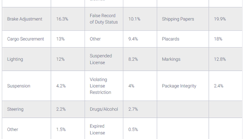Commercial motor vehicle enforcement personnel throughout Canada and the United States conducted 67,502 roadside inspections on large trucks and buses as part of the Commercial Vehicle Safety Alliance's (CVSA) International Roadcheck inspection and three-day enforcement initiative, June 5-7, 2018. These inspections occurred at inspection sites, weigh stations and roving patrol locations along roadways.
During an inspection, if a CVSA-certified inspector identifies critical inspection items on a vehicle with specific violations, he or she will render the vehicle out of service, which means mechanical defects must be corrected for the vehicle to be permitted to proceed. A driver found to be in violation of the conditions in the out-of-service criteria, will be placed out of service until the condition can be rectified.
From all inspections, inspectors identified 11,897 vehicles with out-of-service conditions and 2,664 drivers with out-of-service conditions. Of the North American Standard (NAS) Level I Inspections conducted, 21.6 percent of commercial motor vehicles were placed out of service. Of all NAS Level I, II and III Inspections, 3.9 percent of drivers inspected were placed out of service.
Each year, special emphasis is placed on a certain category of violations. This year’s focus was on hours-of-service compliance. Since the electronic logging device (ELD) mandate went into effect on Dec. 18, 2017, throughout the United States, and with CVSA's NAS Out-of-Service Criteria effective April 1, 2018, this year’s International Roadcheck, held two months after out-of-service enforcement began, served as the perfect opportunity to highlight the importance of hours-of-service regulations and compliance.
Hours-of-service violations represented 43.7 percent of all driver out-of-service conditions; however, of the total number of inspections conducted during International Roadcheck, less than 2 percent of drivers were placed out of service for hours-of-service violations.
CVSA pulled and analyzed data from the International Roadcheck and the U.S. Federal Motor Carrier Safety Administration’s (FMCSA) Motor Carrier Management Information System (MCMIS) and collected and submitted it through CVSA’s Canadian jurisdictions to report overall statistics from Canada and the United States for 2018 International Roadcheck.
- A total of 67,502 Level I, II, and III Inspections were conducted.
- 21.6 percent of commercial motor vehicles that received Level I Inspections were placed out of service; 3.9 percent of drivers who received a Level I, II, or III Inspection were placed out of service.
- There were 15,981 vehicle out-of-service conditions; 3,035 driver out-of-service conditions; and 211 hazardous materials/dangerous goods (HM/DG) out-of-service conditions.
- Most of the inspections (45,400) were NAS Level I Inspections. A Level I Inspection is a 37-step procedure that includes examination of driver operating requirements and vehicle mechanical fitness. Other inspections conducted included the NAS Level II Walk-Around Inspection (11,458) and the NAS Level III Driver-Only Inspection (10,644).
- The top vehicle out-of-service conditions were for brake systems (4,536), tires and wheels (3,058) and brake adjustment (2,612). The top driver out-of-service conditions were for hours of service (1,326), wrong class license (648) and false record of duty status (308).
- 736 motorcoaches were inspected.
- 60,321 inspections were conducted in the United States; 7,181 inspections were conducted in Canada.
Of all vehicle violations, vehicle-related results are as follows:
- 21.6 percent (9,819) of vehicles that had a Level I Inspection conducted (45,400) were placed out of service for vehicle-related violations.
- The top three out-of-service vehicle violations were for brake systems (28.4 percent), tires and wheels (19.1 percent) and brake adjustment (16.3 percent).
- Of the vehicles carrying HM/DG that had a Level I or II Inspection conducted, the vehicle out-of-service rate was 13.1 percent.
- Of all HM/DG out-of-service vehicle violations, the top three were for loading (25.6 percent), other HM (21.3 percent) and shipping papers (19.9 percent).
- Brake adjustment and brake system violations combined to represent 44.7 percent (7,148) of all out-of-service vehicle violations.
- 9.4 percent of the motorcoaches that received a Level I Inspection were placed out of service for vehicle violations.
Of all driver violations, driver-related results are as follows:
- 3.9 percent (2,664) of drivers who received a Level I, II or III Inspection were placed out of service for driver-related violations.
- Of the drivers operating vehicles carrying HM/DG who were inspected, 1.7 percent were placed out of service for driver violations.
- 1.4 percent of the motorcoach/bus drivers who received a Level I, II or III Inspection were placed out of service for driver violations.
- Of all driver out-of-service conditions, the top three were for hours of service (43.7 percent), wrong class license (21.4 percent) and false record of duty status (10.1 percent).
- There were 729 safety belt violations.
The specific out-of-service (OOS) percentage distributions (numbers indicate a percentage of the total out-of-service violations by category) from 2018 International Roadcheck are shown below:
Once violations of the regulations have been identified and documented on a roadside inspection report, roadside enforcement personnel use the CVSA NAS Out-of-Service Criteria as the pass-fail criteria for inspections.
If no violations of the critical vehicle inspection items are found during an eligible inspection, a CVSA decal will be applied as a visual indicator that the vehicle successfully passed inspection conducted by a CVSA-certified inspector. The NAS Level I Inspection and NAS Level V Vehicle-Only Inspections are the only inspections eligible for issuance of a CVSA decal.




